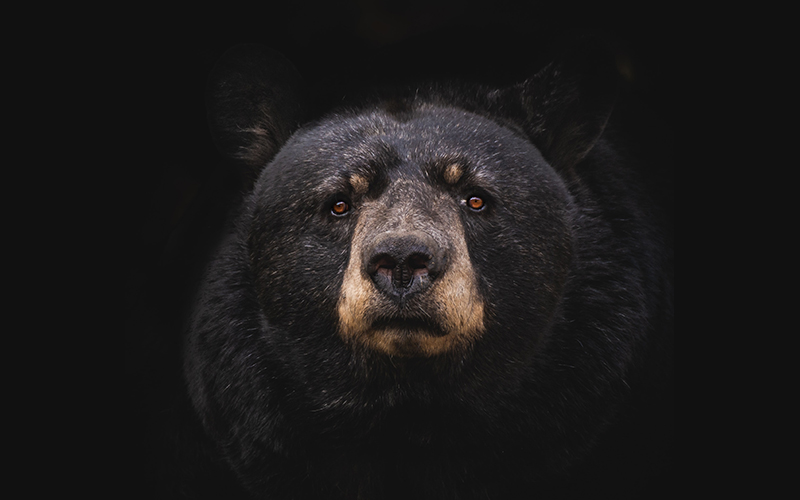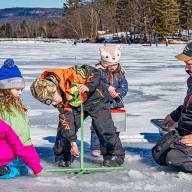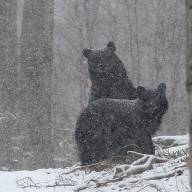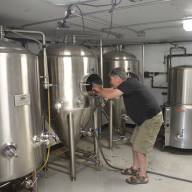The fact that bears mate in summer and give birth seven or eight months later might make you think that bear pregnancies aren’t all that different from human ones. But even though bears mate in summer, they’re not officially pregnant until late fall. Nevertheless, they give birth a few short months later, in January or February.
A TWO-STEP PREGNANCY
Mother Nature has engineered a unique two-step pregnancy process for bears. During step one (mating), eggs are fertilized, but don’t implant or begin to further develop. Several months later, development (step two) begins when the fertilized eggs finally implant. This process is called delayed implantation.
Implantation is delayed because if the bear is underweight, sick or injured, the fertilized eggs may not implant or develop any further. Instead, the eggs can be reabsorbed in order to give the bear the best chance to survive and breed again.
During late summer and fall, an almost-pregnant bear works very hard at gaining as much weight as she possibly can so she has enough fat reserves to sustain herself and produce an abundant supply of the rich milk her cubs will need to fully develop. Then it’s on to step two. Implantation generally occurs and development begins in earnest once the bear is safely tucked into her den.
NEWBORN TO FURRY CUB
Black bear cubs usually weigh in at under a pound, far less as a percentage of mom’s weight (less than 1/150th) than most mammals, including humans, where it’s normal for a 140-pound woman to give birth to an 8-pound bundle of joy that weighs in at 5% of mom’s weight.
At birth, cubs’ eyes and ear canals are closed. The tiny cubs are covered in a coat of exceptionally fine, short hair; their teeth have yet to emerge. But cubs are born with a strong survival instinct. They quickly snuggle up to their mom and siblings to stay warm and settle in to feast on a steady diet of highly nutritious milk. Bear cubs love to eat; they make happy purring, humming noises while they are suckling.
It’s the perfect recipe (super-rich food and little activity) for packing on 4 to 8 pounds before tumbling out into the world about 13 weeks later, usually sometime in April or May.
EAR FLAPS OPEN
When they’re about six weeks old their bright blue eyes and ear flaps open. About 10 days later teeth erupt. As they continue to grow, their fine hair becomes a protective fur coat. By the time they emerge from their snug winter dens, the furry bear cubs have razor sharp little teeth and claws; they’ll be able to climb a tree lickety-split before they’re three months old.
How many cubs are born? Typically, two to three, but there can be as few as one, or rarely, as many as six. Exceptionally large litters can be a sign that mom’s been eating a steady diet of super-fattening human-provided foods and will most likely soon be teaching her cubs to seek out those same familiar food sources. Just another good reason to make sure all your attractants are safely stowed away before bears wake up and go exploring.
HARD-WORKING MOMS
Bears are amazing and dedicated moms. They spend the summer and fall industriously searching for food for themselves and their rapidly growing cubs, and patiently teaching the youngsters how to forage for food, find shelter and develop all the skills they will need for life on their own. Female bears mate every other year at most; cubs born this year will den up with their moms come winter and then strike out on their own the following summer, giving mom a chance to start a new family.
A cub getting into your garbage, bird feeder or pet food might seem cute and harmless, but the very best thing you can do to help cubs grow up and stay wild is to make sure you don’t teach them to associate people with food. Teaching bears to depend on human food creates nothing but problems for people and bears.
Download the free “How BearWise Are You?” checklist (at https://bearwise.org/bearwise-store/How-BearWise-Are-You-CHECKLIST-p534874788) that shows you all the things around your home that might attract bears and gives you tips for being BearWise at home.
Posted by the MRV Bear Initiative with permission from BearWise®. The MRV Bear Initiative is a volunteer working group represented by conservation organizations in Duxbury, Fayston, Moretown, Waitsfield and Warren, Friends of the Mad River, Stark Mountain Foundation, and Sugarbush Resort. Our goal is to collectively improve our understanding of and how to coexist with our calorie-seeking, black bear neighbors. Check out the Initiative’s resource pages at
https://www.madrivervalley.com/stewardmrv/living-with-bears/ and BearWise at https://bearwise.org.
Check out the Great Amazing Bear Story Contest at https://www.madrivervalley.com/stewardmrv/living-with-bears/5-great-amazing-bear-contest/. The MRV Bear Initiative wants to hear your best bear stories from 2023. Win cool prizes! All ages welcome!!













